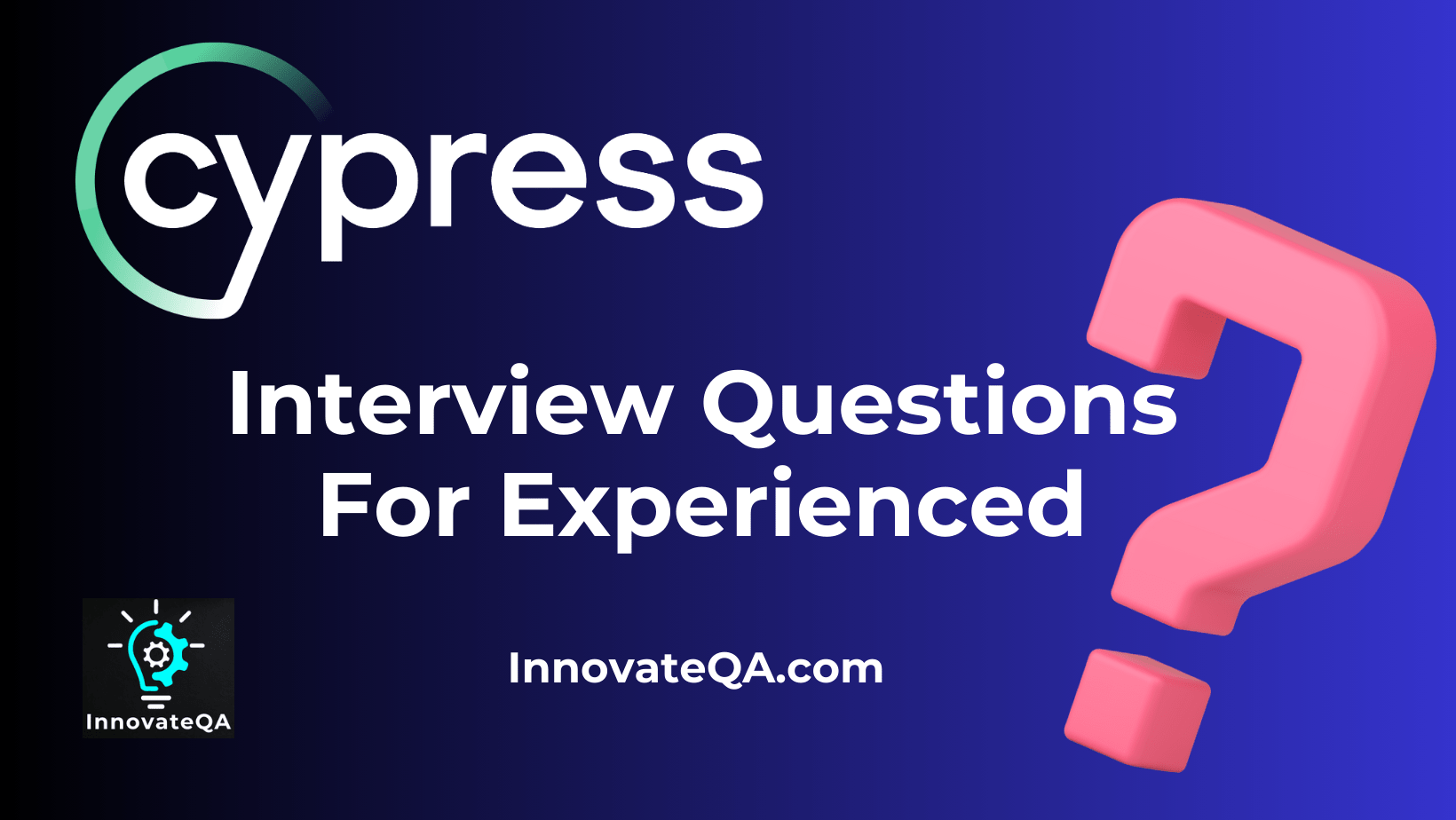Table of Contents
ToggleIntroduction
Mastering Cypress is not only a valuable skill for test automation engineer but also a key asset in securing a job in the competitive tech industry. By thoroughly understanding the Cypress Interview Questions For Experienced covered in this article, you’ll be well-equipped to showcase your expertise and confidently tackle any Cypress-related interview.
In the last article we have seen some Top Cypress Interview Questions.
What is the purpose of the cy.route() command in Cypress?
The cy.route() command is used to intercept and stub network requests in Cypress tests. It allows you to control the behavior of network requests, simulate different responses, and test how the application reacts to various scenarios.
How can you integrate Cypress tests into a continuous integration (CI) pipeline?
Cypress tests can be integrated into a CI pipeline by installing Cypress as a dependency, configuring the test script, and running the tests using a CI service like Jenkins, Travis CI, or GitHub Actions.
Discuss the concept of Cypress commands chaining.
Cypress commands can be chained together to form a series of actions and assertions. Chaining commands allows you to express the flow of your test in a more readable and concise manner.
How does Cypress handle browser compatibility testing?
Cypress primarily focuses on testing within the Chrome browser. However, you can use services like BrowserStack or Sauce Labs in combination with Cypress to run tests on multiple browsers and ensure cross-browser compatibility.
Explain the concept of fixtures in Cypress. How are fixtures useful in testing?
Fixtures in Cypress are used to load external data into tests. This can include JSON, XML, or any other data format. Fixtures are useful for testing scenarios where you need to work with specific data sets, such as testing different user roles or data variations.
What is the purpose of the cy.viewport() command in Cypress?
The cy.viewport() command is used to set the dimensions of the browser’s viewport during a test. It allows you to simulate different screen sizes and test the responsiveness of your application.
How can you handle dynamic elements in Cypress tests?
Cypress provides various strategies to handle dynamic elements, such as using aliases, retries, and waiting for specific conditions. Additionally, you can use the cy.get() command with appropriate selectors to wait for an element to be available.
Discuss the concept of snapshots in Cypress. How do they aid in testing?
Snapshots in Cypress capture a screenshot of the application at a specific point in time. They help in visually comparing the application’s state between test runs, making it easier to identify visual regressions.
What are the benefits of using Cypress for API testing?
In addition to UI testing, Cypress can also be used for API testing. It provides a clean API for making HTTP requests and assertions on the responses. The same testing framework can be used for both UI and API testing, promoting consistency in testing approaches.
Explain the Cypress folder structure.
The Cypress folder structure is designed to provide an organized and logical layout for your Cypress projects. Understanding the folder structure is essential for efficient test development and maintenance. Below is an explanation of the typical Cypress folder structure:
- cypress/
- fixtures/
- This folder contains fixture files, which are external pieces of static data used in your tests. Fixtures are commonly used to mock data for testing purposes.
- e2e (earlier integration)/
- The integration folder is where you organize your test files. By default, Cypress looks for tests in this folder. You can create subfolders to further organize your tests based on features or functionalities.
- plugins/
- Cypress supports a plugin system, and this folder is where you can define custom plugins to extend or modify Cypress’s behavior. Plugins can include commands, tasks, or other custom functionalities.
- screenshots/
- When tests fail, Cypress automatically captures screenshots and places them in this folder. This helps developers identify the state of the application at the time of failure.
- videos/
- Cypress records test runs as videos by default. The videos folder contains the recorded videos of test executions, aiding in diagnosing issues or reviewing test results.
- support/
- The support folder is used for storing reusable code and utility functions that can be shared across multiple test files. Commonly used for custom commands, fixtures, and other utilities.
- cypress.config.js (earlier cypress.json)
- The Cypress configuration file, where you can specify various settings and configurations for your Cypress project. This includes configuration options like the base URL, browser settings, and more.
- node_modules/
- This folder contains the dependencies and packages required for your Cypress project. It is generated when you install Cypress using npm or yarn.
- package.json
- The package.json file is a standard Node.js configuration file that includes metadata about the project and its dependencies. It also specifies scripts for running Cypress commands.
- cypress.env.json
- cypress.env.json can store environment-specific configuration values.
How does Cypress handle cross-origin (CORS) issues during testing?
Cypress automatically gets around CORS limitations so you can communicate with elements from multiple origins and send requests to different domains without any problems.
What is the purpose of the Cypress plugins file?
Cypress can be extended by adding third-party plugins or defining custom functionality using the Cypress plugins file (‘index.js’ or ‘index.ts’). Tasks like browser launches, webpack settings, and other things can be configured using it.
How do you parameterize tests in Cypress?
Tests can be parameterized using Cypress through using data-driven methodologies. To parameterize test inputs and expected results, you can use tools such as custom commands, fixtures, or Mocha’s data-driven tests.
Explain the concept of Aliases in Cypress and why they are useful.
In Cypress, aliases facilitate the creation of references to items or values, hence facilitating their reuse across many commands and assertions. They aid in the creation of test code that is easier to understand and maintain.
How do you locate elements in Cypress?
Similar to other testing frameworks, Cypress offers a variety of methods for locating items. CSS selectors are the main way to locate elements, but Cypress offers various alternative approaches as well. Here are a few typical methods for finding elements in Cypress:
CSS Selectors:
- Utilize standard CSS selectors to target elements, for example:
cy.get('#myElement') // Select by ID
cy.get('.myClass') // Select by class
cy.get('button') // Select by element type
Custom Attributes:
- Leverage custom attributes to uniquely identify elements:
cy.get('[data-test="myElement"]') // Select by custom attribute
Combining Selectors:
- Combine multiple selectors for more specific targeting:
cy.get('ul#myList li:first-child') // Combination of selectors
Alias for Reusability:
- Use aliases to store elements for reuse in later commands:
cy.get('input').as('myInput')
cy.get('@myInput').type('Cypress is awesome!')
Child and Sibling Selectors:
- Navigate the DOM using child and sibling selectors:
cy.get('.parent-class > .child-class') // Select a child element
cy.get('.sibling-class + .sibling-class') // Select a sibling element
Pseudo-Classes:
- Utilize pseudo-classes for specific states or positions:
cy.get('input:visible') // Select visible elements
cy.get('li:nth-child(3)') // Select the third child element
Contains and Within:
- Use
containsto select elements with specific text andwithinto scope selections:
cy.contains('Submit') // Select element containing text 'Submit'
cy.get('.parent').within(() => {
cy.get('.child') // Select within a specific parent
})
How does Cypress handle test parallelization?
Cypress supports test parallelization, allowing you to run tests concurrently. This can cut down on the total amount of time needed to execute the test. You can use tools like Cypress Dashboard or CI/CD platforms to achieve parallel test runs.
Explain the concept of page objects in Cypress. How do they contribute to test maintainability?
Page objects in Cypress are a design pattern that involves encapsulating the interactions with a specific page of the application in a separate object. This promotes reusability, readability, and easier maintenance of tests as changes to the page structure can be localized to the corresponding page object.
What is the role of the cy.intercept() command in Cypress?
The cy.intercept() command in Cypress is used to intercept and modify HTTP requests. It allows you to stub network requests, simulate different server responses, and test how the application handles various API scenarios.
Explain the concept of headless testing in Cypress. What are the advantages and potential challenges of using headless mode?
Headless testing in Cypress involves running tests without a graphical interface. This can be advantageous for running tests in environments without a display server. However, challenges may arise in scenarios where visual elements or interactions are crucial for testing.
Explain the concept of network stubbing in Cypress. When and why would you use it?
Network stubbing in Cypress involves intercepting and controlling network requests. You might use it to simulate different server responses, test error handling, or isolate specific parts of your application for testing without relying on actual backend services.
You May Also Like
🔝4️⃣5️⃣➕ Manual Testing Scenario Based Interview Questions 2024 🚀
🤖 🔝6️⃣5️⃣ ➕Automation Testing Interview Questions 2024 🚀
🔝6️⃣5️⃣➕ API Testing Interview Questions 2024 🚀
🔝6️⃣5️⃣➕ Postman Interview Questions 2024 🚀
🔝3️⃣0️⃣➕ Cucumber Interview Questions 2024 🚀
🔝5️⃣0️⃣➕ TestNG Interview Questions 2024 🚀
🤖🔝💯+Selenium Interview Questions For Experienced 2024 🚀
🍵Top 💯+ Java Interview Questions For Automation Testing 2024 🚀
🔝6️⃣5️⃣➕ JMeter Interview Questions 2024 🚀
Playwright Interview Questions

